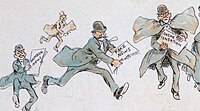
Photo from wikipedia
Significance Few people are prepared to effectively navigate the online information environment. This global deficit in digital media literacy has been identified as a critical factor explaining widespread belief in… Click to show full abstract
Significance Few people are prepared to effectively navigate the online information environment. This global deficit in digital media literacy has been identified as a critical factor explaining widespread belief in online misinformation, leading to changes in education policy and the design of technology platforms. However, little rigorous evidence exists documenting the relationship between digital media literacy and people’s ability to distinguish between low- and high-quality news online. This large-scale study evaluates the effectiveness of a real-world digital media literacy intervention in both the United States and India. Our largely encouraging results indicate that relatively short, scalable interventions could be effective in fighting misinformation around the world. Widespread belief in misinformation circulating online is a critical challenge for modern societies. While research to date has focused on psychological and political antecedents to this phenomenon, few studies have explored the role of digital media literacy shortfalls. Using data from preregistered survey experiments conducted around recent elections in the United States and India, we assess the effectiveness of an intervention modeled closely on the world’s largest media literacy campaign, which provided “tips” on how to spot false news to people in 14 countries. Our results indicate that exposure to this intervention reduced the perceived accuracy of both mainstream and false news headlines, but effects on the latter were significantly larger. As a result, the intervention improved discernment between mainstream and false news headlines among both a nationally representative sample in the United States (by 26.5%) and a highly educated online sample in India (by 17.5%). This increase in discernment remained measurable several weeks later in the United States (but not in India). However, we find no effects among a representative sample of respondents in a largely rural area of northern India, where rates of social media use are far lower.
Journal Title: Proceedings of the National Academy of Sciences of the United States of America
Year Published: 2020
Link to full text (if available)
Share on Social Media: Sign Up to like & get
recommendations!